6 facts about the New York mayoral election
How Brad Lander, not Zohran Mamdani, won the media race.
Data and replicable code for this post can be found here.
In just a few days, votes will be tallied for the top job in America’s biggest city.1
And it’s not a New York mayoral race without drama. Take your pick this year: incumbent mayor Eric Adams weighed down by a litany of weird scandals, playing make-your-own-party by running as the ‘Safe Streets, Affordable City’ candidate; former governor Andrew Cuomo juggling his own set of scandals and resulting investigations, from mishandling the state’s COVID response to serious sexual harassment allegations; Zohran Mamdani, progressive socialist and former 2010s-era rapper, courting the ‘hot girls’ of Brooklyn while facing down car-bomb threats; the racist ‘terrorist-beard’ campaign ads; the cafeteria lunch table alliances and frenemies that ranked-choice voting spurs on; and the general existence of Paperboy Prince, whose perennial candidacy kicked off with a sincere and detailed 40 minute testimony on the local budget at a finance committee public meeting.
As we head into the last days of the race (and perhaps as you head to the poll), here are eight facts — some well known, some not at all — about the candidates and the state of the race.
Fact 1: There are clear, but narrow ideological differences between the candidates. They don’t map cleanly onto ‘liberal’ and ‘conservative’.
For the outside observer — the kind who’s ironically quite important in politics — the NYC mayoral race likely feels both boring and confusing: a lineup of liberal or liberal-ish Democrats with differences buried in the details.
One way to ideologically position electoral candidates is to compare the fine linguistic distinctions in they describe their own platforms using large language models.2 I had GPT-4o identify these “ideal points” for the top four candidates (as of early June), based on key issues from the first two primary debates, like affordability, immigration, and public safety.
The result looks something like this:
… which is completely unsurprising if you’ve at all picked up on the vibes of these candidates. What’s more interesting is what the diagram doesn’t show: the underlying dimensions of local political ideology that shape and complicate the left-right spectrum itself.
First, there is the familiar axis of national orientation. With the continuing nationalization of politics in the Trump era, there’s a strong incentive for candidates stake out positions on issues like Israel/Palestine, Trumpism, and ICE enforcement. Some of this is about courting media attention with clarifying, but symbolic rhetoric in an increasingly fragmented attention economy.
But many of these issues — sanctuary city protections, gender-affirming care — sit at the intersection of national policy and local implementation. For local Democrats, preempting national rules and setting local enforcement standards carry even more weight given the failure of national Democrats to enact broad protections in these arenas. On many of these, Cuomo would sit well to the left of the national GOP. Nevertheless, positions on Israel are particularly divided within those otherwise on the progressive left (see the newly coined “Progressive-Except-Palestine”).
Second, there is the axis of fiscal orientation. Much of local politics is about spending taxpayer dollars on basic, ‘unopinionated’ quality-of-life services. Cue the Fiorella “Mr. New York” LaGuardia quote - ‘there is no Democrat or Republican way to pick up garbage’ (or get rid of huge rats).
Except New York City has a massive budget of more than $100 billion, an amount larger than the budgets of most states. Because of this, many NYC municipal conflicts sound less like the debates in suburban aldermen meetings (who to hire to clean the streets) more like the high-stakes fights on the floors of Congress (whether to support or cut big, broad, ‘opinionated’ social programs). Cities must spend a lot, just not enough to drive away capital. All serious mayoral candidates recognize this and support expanding basic and popular programs like universal pre-K. The difference is in magnitude: much more of Zohran’s pie would go to the latter than Cuomo’s. These differences map neatly onto their national analogues — Zohran collects his stamps of approval from AOC and Bernie, Cuomo gets his from Ritchie Torres and Jim Clyburn.
Finally, there’s perhaps the classical local political cleavage of market orientation. This is not about how big the pie is, nor about who gets what slice, and more about how it’s sliced and doled out — who builds housing (union vs. non-union labor) and how services are delivered (public vs. private contractors). In a sense, this is about conservatism in a ‘small-c’ sense (i.e., fiscal efficiency vs. alliance with organized labor).
But proponents of the growing abundance liberalism movement would say it is also about trade-offs in procedures (i.e., how democratically decisions are made) and time horizons (i.e., moderate redistribution now vs. more redistribution later). Abundance liberals would argue that some market orientation (e.g., favoring market-rate housing development in order to increase supply) would actually favor more progressive outcomes (more units that can be subsidized at a lower cost for low-income tenants). On this dimension, the candidate field isn’t exactly flipped, but the more moderate candidates tend be more credibly market-oriented.
Fact 2: Cuomo is meaningfully ahead in the polls. Polling this race is both more and less fragile than national elections in different ways.
According to the most recent polling average, Andrew Cuomo is ahead of Mamdani by 8 points in first-choice support. We should probably not be surprised. If we’ve learned anything from the past ten years, it’s to never underestimate name recognition - especially the last names of men that have been in headlines (good or bad) for more than half a century.
That said, Cuomo’s lead is short of the 20 point lead he had a month ago and short of the majority he needs to win. This means, given the coalition-building mechanics of ranked-choice voting, our understanding of the race depends heavily on correctly intuiting the second-choice preferences of the bottom-of-the-barrel candidates. It’s hard enough to ask people about their first choices in any kind of survey! Throw in the fact that it’s a local primary race absent of any partisan cues, and you’ve got an uphill battle as a pollster.
On the other hand, the kinds of selection bias that plague national polls are less of a problem here. The people who respond to these polls are, generally speaking, the kinds of people who actually vote in an off-cycle mayoral primary.
It is true that the polls were, at one point, “wrong” about the winner of the 2021 mayoral race. Andrew Yang led in multiple polls but collapsed by June, ultimately placing fourth. Eric Adams didn’t take the lead until early May — around the start of early voting — and went on to win. There’s a difference this year and that’s Cuomo’s name recognition and a wide coalition, and there's no late-breaking candidate with the kind of coalition Adams managed to assemble. At least that we currently know of.
Fact 3: Zohran is a social media (Gen-Z) darling, not a legacy media (boomer) darling. That may not actually matter.
If you’re a New Yorker below the age of 40 and you’re at all tuned into politics, you know one thing: Zohran Mamdani is The Media Candidate. Right?
It turns out this is totally untrue if you look at the media landscape beyond TikTok, Instagram, and YouTube.
Counting online news stories mentioning the four front-runners from more than 300 state and local outlets, Cuomo led in mentions on-and-off for the entire year so far. Mind you, these include mentions of the DOJ investigation into his administration’s COVID-19 nursing home death miscounts and also indirect mentions as Eric Adams announced his independent run. But to recall another lesson we should never forget from Cuomo’s foil-not-foil: all earned media is good media.
This all changed a few days when Brad Lander was arrested (and, importantly, pictured being arrested) at immigration court.
Ok, so the the word-reading olds aren’t hearing as much about Zohran as the Instagram-scrolling youths. But, given the historic over-participation of the former in local elections and the recent under-participation of the latter, this might be exactly the right turnout strategy from the Mamdani campaign - taking a page out of the venerable Obama playbook.
Now, going back to Lander for a second…
Fact 4: Lander may be the winner of the ‘airwaves race’.
Lander’s June 17th arrest has generated a greater supply of news coverage than any other event for any other candidate in this race (and, based on Google Trends, very likely maxed out his name recognition). This is especially stark if you look at national media:
National news coverage is, of course, important for national fundraising support, the likes of which Cuomo has enjoyed (from Democrats and Republicans) more than his rivals. Impressive late-breaking ‘earned media’ moments like these still tend to decay, which we already see above. As of Sunday June 22, Brad Lander stands slightly ahead in national media mentions. It remains to be seen whether this October Surprise will drum up meaningful Lander turnout on Election Day.
Fact 5: There’s a very sharp divide in the kinds of people who support each candidate.
Campaign donations, which are public record and require disclosures of occupation, employer, and address, can tell us a little bit about the kinds of people who support these candidates. (Caveat: people who donate are a subset of and often do not fully overlap with people who vote, but presumably strongly support those candidates).
The New York Times has a great map of candidate support at the neighborhood level and it’s telling: Mamdani’s donor base is geographically wide but concentrated in the areas that Patrick Ruffini calls “Gentrification 1.0 and 2.0” like Bed Stuy and Williamsburg, Adrienne Adams draws her support from the black outer boroughs such as southeast Queens, Lander from Brooklyn’s wealthy white Park Slope liberals, and Cuomo’s from scattered regions like the Upper East Side, “Orthodox Brooklyn”, and pockets of Staten Island.
In raw numbers, Mamdani has the most donors of any candidate, and though his support is broad across industries, he enjoys the greatest following in the tech crowd (Bernie bros, anyone?). Adrienne and Brad draw the most donors among the unemployed, though this includes the self-employed, homemakers and (some) retirees. The legal and education professions are coming through for Brad and Zohran, while business and real estate are for Cuomo.
But, of course, not all donors are created equal. Switching to the total dollar amount of donations rather than the number of donors, it’s clear that Cuomo both pulls the biggest and broadest sums across industries — business, real estate, education, finance and consulting. By contrast, Zohran’s fundraising is concentrated in the tech and education sectors while Brad and Adrienne pull their contributions from outside the traditional organizational sectors of the city.
Looking at the more granular occupations of donors gives a better sense of the young and ‘new money’ (Zohran) vs. old and ‘old money’ (Cuomo) poles of mayoral candidate bases, where Lander and Adams both sit somewhere in between:
Fact 6: Cuomo is most likely to win, but don’t bet on it yet.
As of this writing, Zohran actually leads in both funders and overall funds than Cuomo ($8.4 million vs. $7.8 million), thanks in part due to public match funds withheld to the Cuomo camp due to fishy coordination between the campaign and their super PAC. Thanks to former Mayor Bloomberg’s last minute cash infusion, though, Cuomo is catching up.
Cuomo is also winning the ad war, throwing millions of dollars on a last-leg negative ad blitz and generally outdoing the Mamdani camp 3-to-1 in TV and digital ad spend. As we know, all else equal, ads actually matter more in local races than in other races in persuading voters’ choice of candidate, and ads (especially negative) seem like a good investment in primary contests.
Cuomo’s team is also running a careful campaign of ‘quiet politics’: focusing on orchestrated solo events, podcast appearances, friendly media hits, minimal unscripted moments, and sidestepping rivals who might revive the scandals that ended his governorship. It’s a playbook for keeping the spotlight while keeping criticism quiet, a page from Trump’s 2020 “Rose Garden” strategy book.
All said, the unpredictability of ranked-choice voting and the fragility of polling models make this a risky race to call, even with double digit hours to go until the end. Neither Cuomo nor Mamdani landed a New York Times endorsement — a sign, recent political science would suggest, of skepticism about candidate quality from traditional power brokers. A race with a front-runner it may be, but no one’s comfortably coasting to Gracie Mansion just yet.
And let’s be real: most PROMINENT city (I SAID IT).
There are also lots of limitations with ideologically scaling political actors based on their speech alone. The credibility, experience, competency, and external context to transform position X and actually enact it into policy X is better captured with other methods that account for the behavior of elected officials. This doesn’t work for local primaries though.




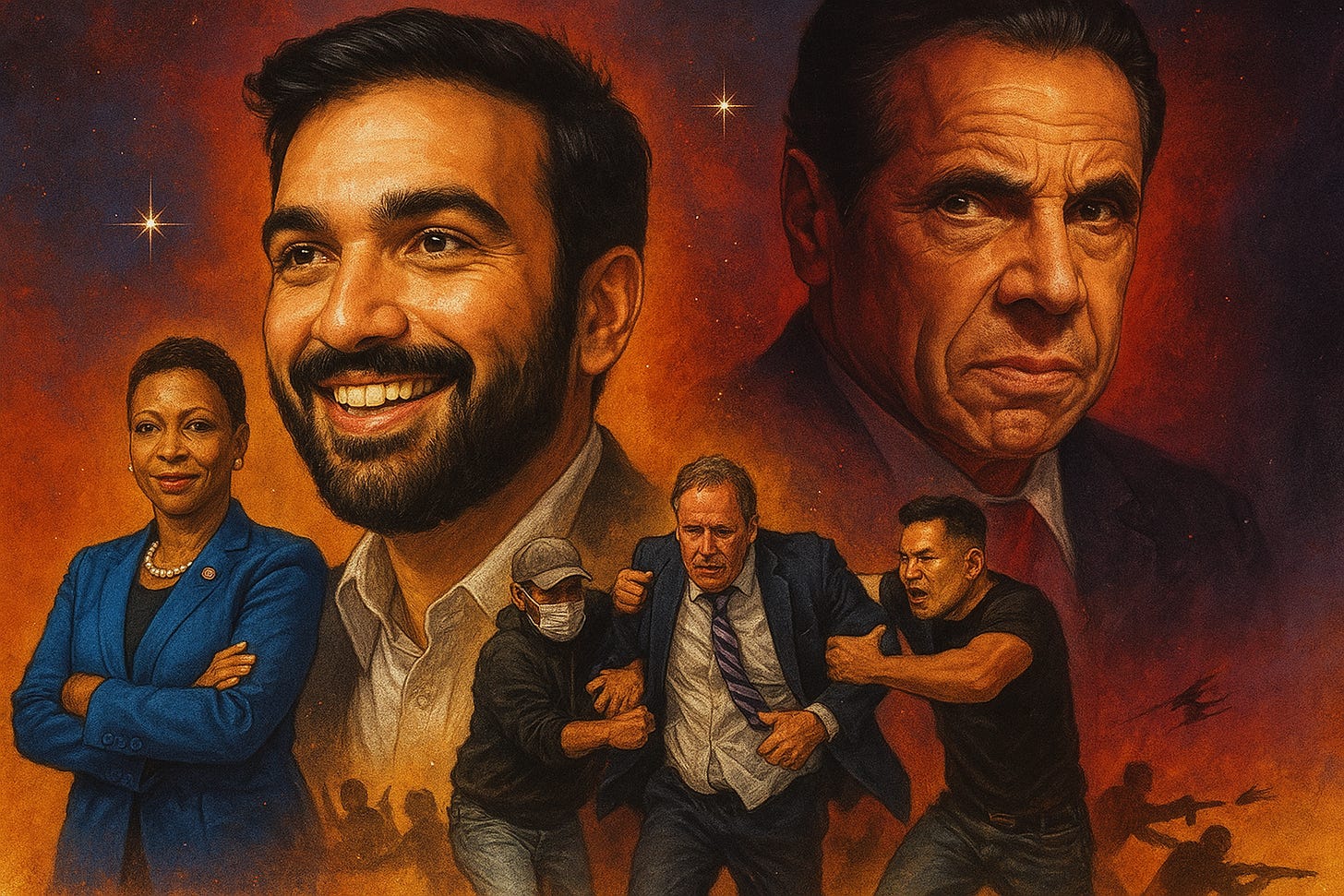

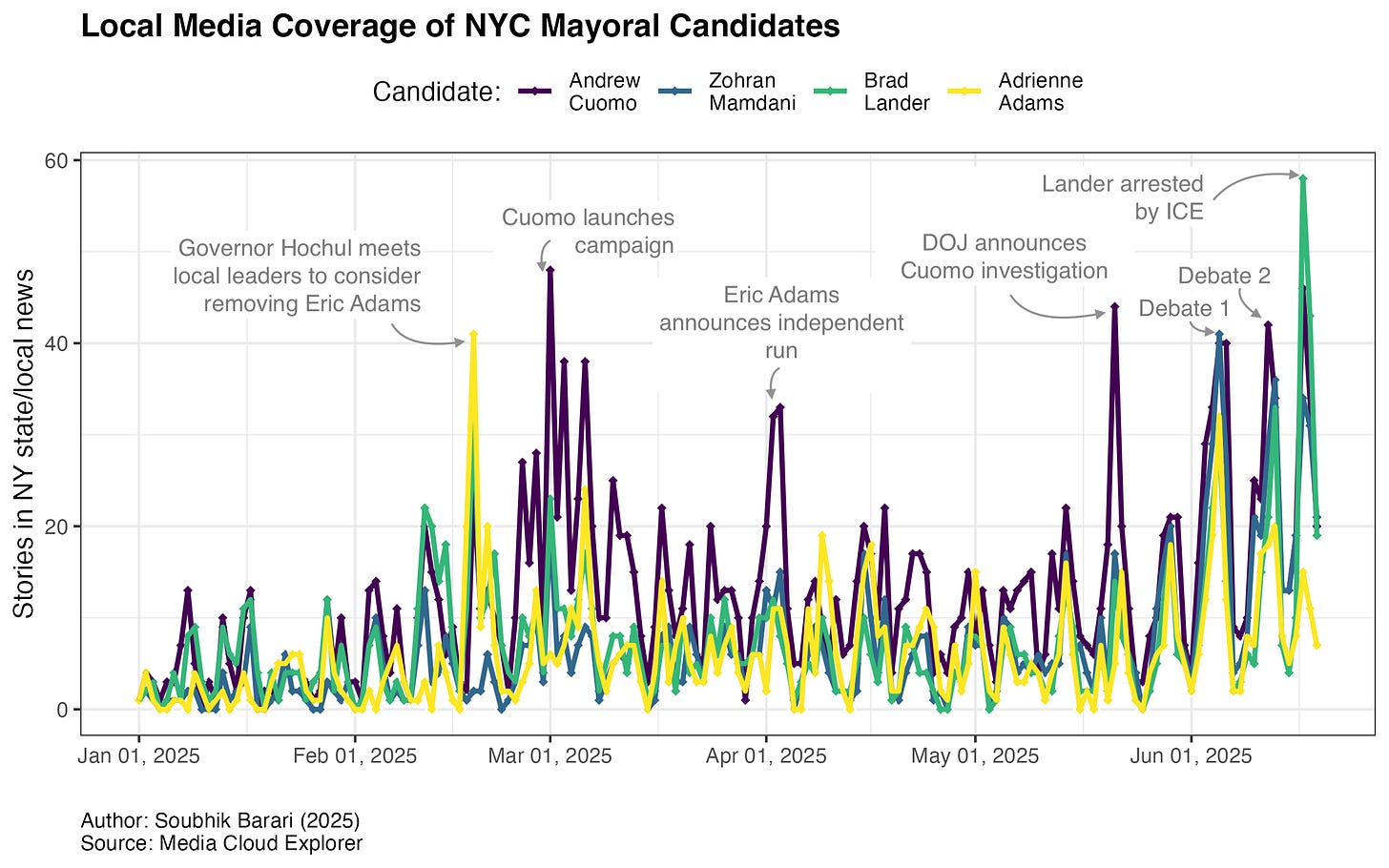
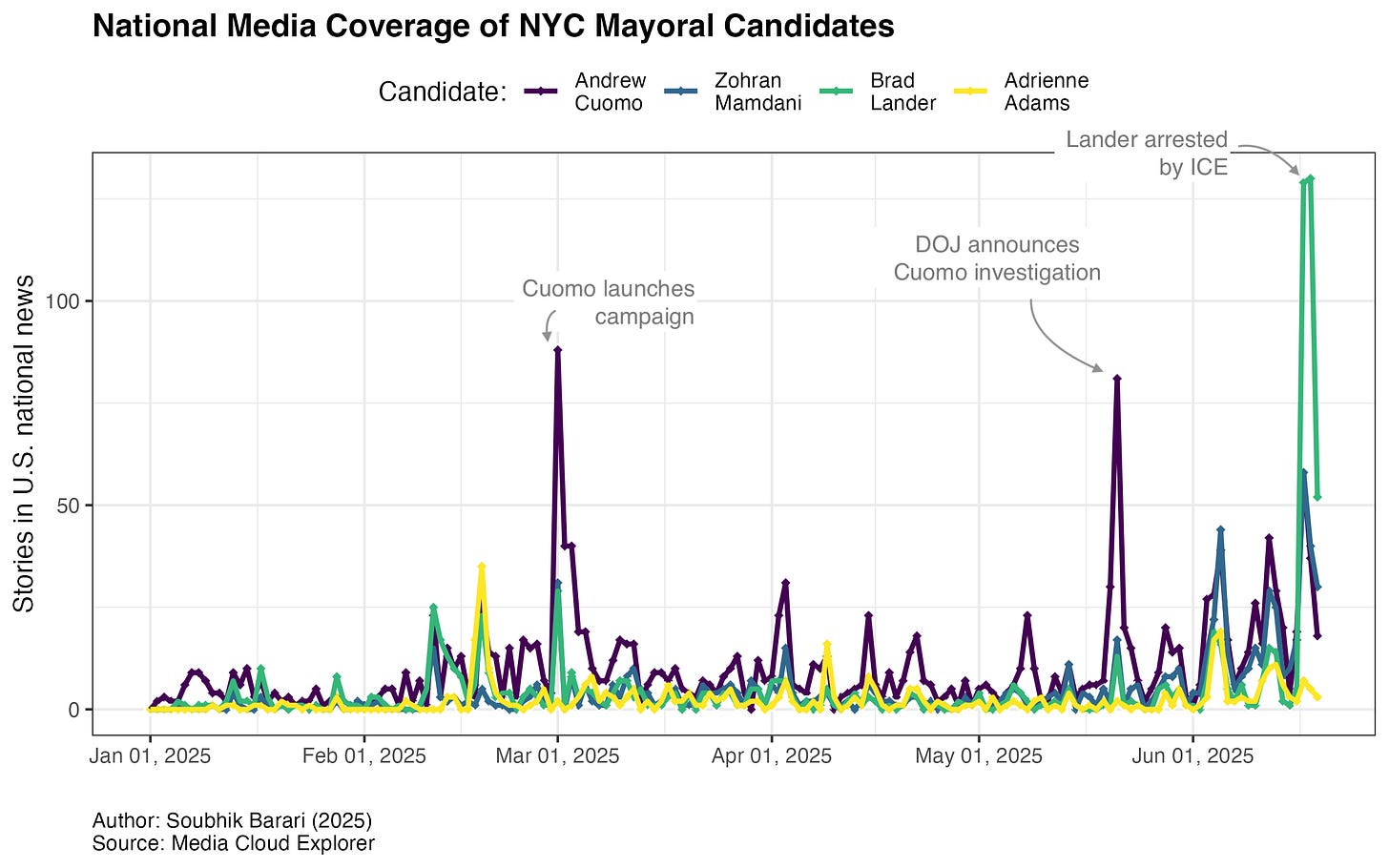
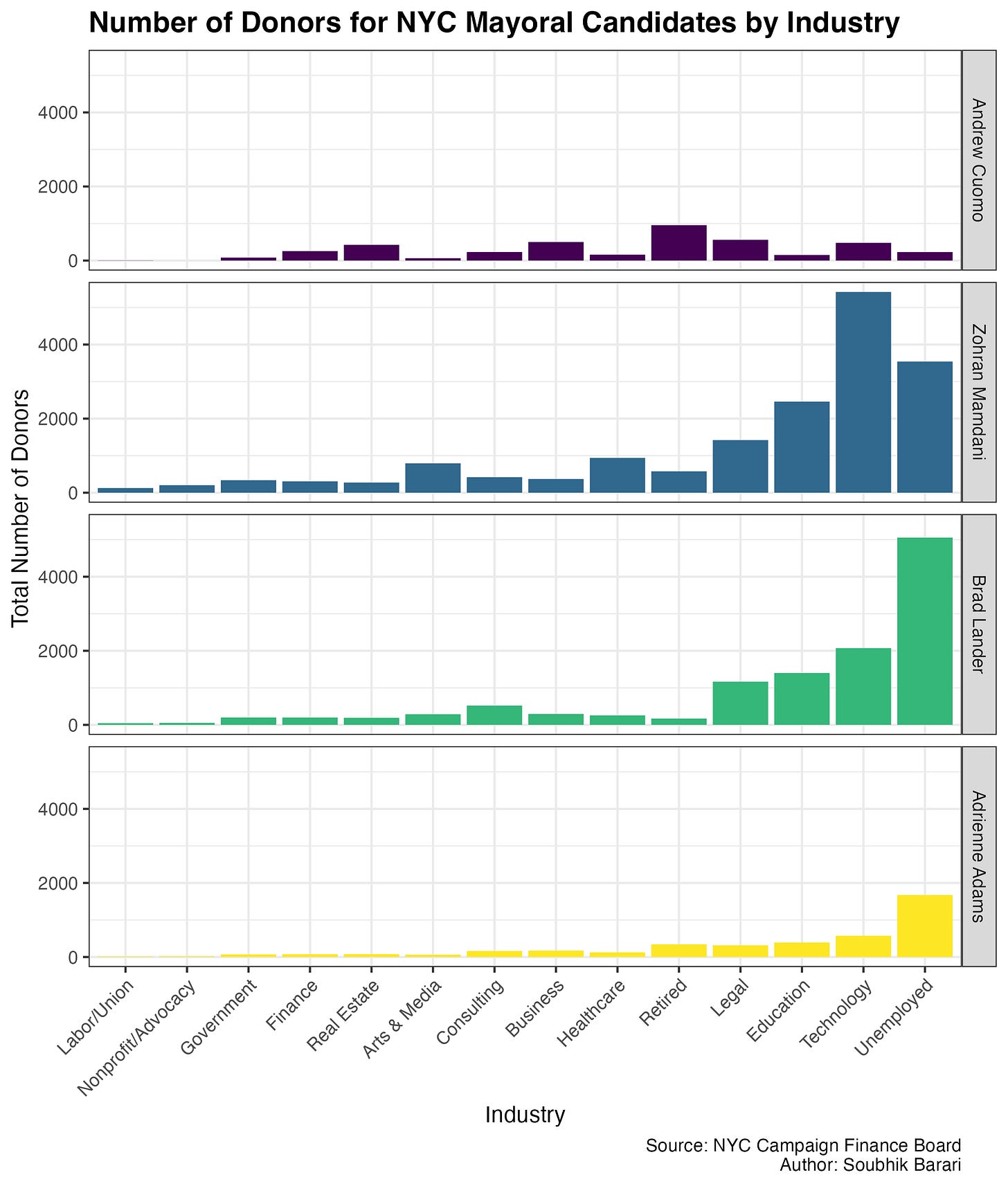
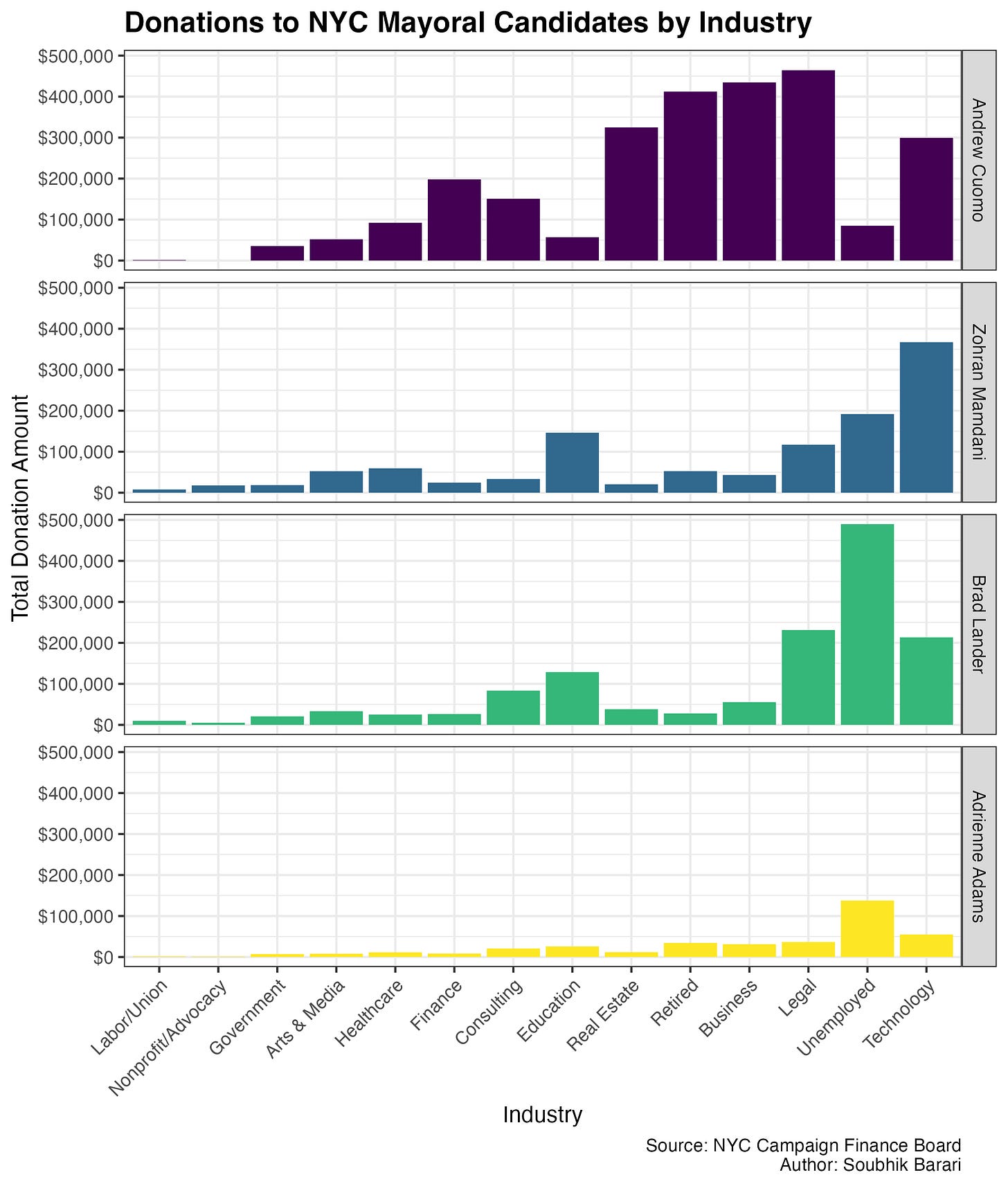

Love all the data vizs